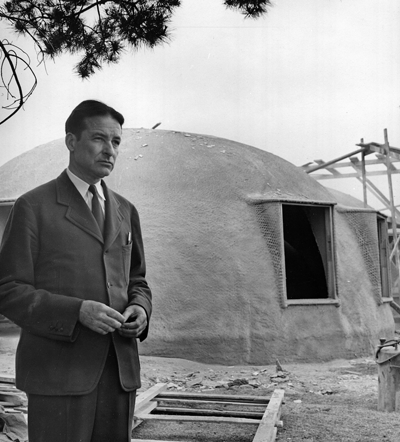
All photos from No Nails, No Lumber by Jeffrey Head (Princeton Architectural Press). Wallace Neff at an Airform construction site.
Architect Wallace Neff made a name for himself in the 1920’s and 1930’s building lavish Spanish-style mansions for Hollywood clients like Douglas Fairbanks, Groucho Marx, and Judy Garland. But his pipe dream was to fill the world with bubble houses: small, inexpensive, domed concrete structures that could be built in just a few days. A new book, No Nails, No Lumber: The Bubble Houses of Wallace Neff, tells the story of his efforts. From 1942 to 1952 Neff helped design and build thousands of bubble houses throughout the world, some of which remain in use even today. In addition to a number of individual bubbles houses in California, a community of twelve was constructed in Falls Church, Virginia, and another community of 1,200 was constructed in Dakar, Senegal. There were bubble house resorts developed in Hobe Sound, Florida and St. Thomas, Virgin Islands. And there were bubble houses built to use as grain storage bins in Litchfield Park, Arizona, as wine vats in Portugal, and as gas stations in Rio de Janeiro, Brazil.
The chief innovation of the bubble house was its patented Airform construction method. After a concrete foundation was poured in the ground, a heavy rubber bubble was inflated on top. Then the bubble was coated in layers of gunite (spray-on concrete), steel mesh, insulation,
Slideshow




 Facebook
Facebook Permalink
Permalink Digg
Digg Reddit
Reddit LinkedIn
LinkedIn StumbleUpon
StumbleUpon Tumblr
Tumblr

